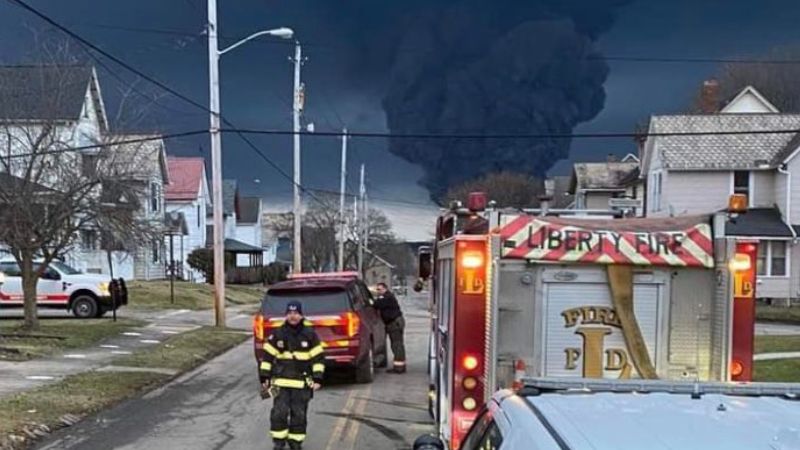Ohio Train Derailment: Lingering Toxic Chemicals In Buildings

Table of Contents
Types of Toxic Chemicals Released and Their Persistence
The Ohio train derailment involved the release of numerous toxic chemicals, with vinyl chloride and butyl acrylate being among the most concerning. These chemicals, and others, possess properties that contribute to their persistence in the environment and their potential to infiltrate buildings.
-
Vinyl Chloride: This colorless, flammable gas is known for its volatility, meaning it readily evaporates into the air. However, it can also persist in soil and groundwater, leading to long-term contamination. Vinyl chloride is a known carcinogen, posing significant health risks.
-
Butyl Acrylate: This colorless liquid is less volatile than vinyl chloride, but it can still evaporate and contaminate the air. It can also absorb into porous building materials like wood and drywall. Exposure to butyl acrylate can cause respiratory irritation, skin irritation, and other health problems.
-
Persistence and Pathways: The volatility and persistence of these chemicals determine how they infiltrate buildings. They can enter through various pathways:
- Air infiltration: Volatile chemicals can penetrate through cracks and gaps in building envelopes.
- Water contamination: Chemicals leaching into groundwater can contaminate building water supplies.
- Soil contamination: Soil contaminated with chemicals can adhere to shoes and clothing, bringing the contaminants inside.
- Absorption into materials: Some chemicals can directly absorb into porous building materials, leading to long-term contamination.
The potential for long-term contamination of building materials is a significant concern. Thorough Ohio train derailment chemical analysis is crucial to understand the extent of the contamination and inform effective remediation strategies.
Health Risks Associated with Lingering Chemicals
Exposure to the chemicals released in the Ohio train derailment poses significant short-term and long-term health risks. The severity of these risks depends on the level and duration of exposure.
-
Vinyl Chloride Health Effects: Long-term exposure to vinyl chloride is linked to an increased risk of several cancers, including liver cancer, brain cancer, and lung cancer. Short-term exposure can cause dizziness, headaches, and respiratory irritation.
-
Butyl Acrylate Toxicity: Exposure to butyl acrylate can cause respiratory irritation, coughing, shortness of breath, skin irritation, and eye irritation. Long-term effects are less well understood but may include chronic respiratory problems.
-
Impact on Vulnerable Populations: Children, the elderly, and pregnant women are particularly vulnerable to the health effects of these chemicals. Their developing systems or pre-existing health conditions make them more susceptible to harm.
-
Diagnosing Chronic Exposure: Diagnosing health problems caused by low-level chronic exposure to these chemicals is challenging. The symptoms may be subtle or mimic other illnesses, making it difficult to establish a direct link to the derailment.
The Ohio train derailment health impact is a serious and ongoing concern requiring continuous monitoring and comprehensive medical care for affected residents.
Testing and Remediation Efforts in Affected Buildings
Testing and remediation efforts in buildings affected by the Ohio train derailment are crucial to mitigate the long-term health risks. However, challenges remain.
-
Testing Methods: Various testing methods are employed:
- Air quality monitoring: Measuring the concentration of volatile organic compounds (VOCs) in the air.
- Water testing: Analyzing water samples for the presence of contaminants.
- Material analysis: Testing building materials for the absorption of chemicals.
-
Remediation Strategies: Remediation strategies vary depending on the extent and type of contamination. They may include air filtration, water purification, and the removal or replacement of contaminated materials.
-
Challenges in Remediation: Identifying and cleaning all contaminated areas is a significant challenge. The pervasive nature of the contamination and the potential for hidden pockets of chemicals make complete remediation difficult.
-
Lack of Transparency: Concerns exist regarding a lack of transparency and the adequacy of the response from authorities regarding the testing and remediation efforts, fueling public distrust and anxiety. The government's Ohio train derailment remediation efforts need to be more open and accountable to the affected residents.
The effectiveness and comprehensiveness of the remediation strategies are still under evaluation, and further investigation is crucial.
Government Response and Accountability
The government's response to the Ohio train derailment has faced criticism regarding both immediate actions and long-term strategies.
-
Adequacy of Response: Questions persist about the speed and effectiveness of the initial response, including the evacuation orders, health screenings, and provision of information to residents.
-
Shortcomings and Lack of Transparency: A lack of transparency in the communication with the affected communities has exacerbated concerns and eroded public trust. Clear and consistent communication is crucial for addressing fears and promoting collaboration.
-
Accountability: Determining accountability for the derailment and its consequences remains a key aspect of the ongoing situation. Thorough investigation and appropriate legal action are essential for preventing future incidents. Establishing clear environmental regulations and ensuring strong regulatory oversight is critical moving forward.
The government response Ohio train derailment needs to be significantly improved to ensure effective and transparent remediation and support for the affected community.
Conclusion
The Ohio train derailment's legacy extends beyond the immediate aftermath, with lingering Ohio train derailment toxic chemicals posing a significant threat to the health and well-being of the community. The presence of these chemicals in buildings necessitates comprehensive testing, effective remediation strategies, and transparent communication from authorities. Failure to address the issue of lingering toxic chemicals will have long-lasting consequences. It is crucial to demand thorough investigations, robust remediation efforts, and increased transparency to ensure the safety and health of those affected. We must continue to monitor the situation and advocate for solutions to the ongoing problem of Ohio train derailment toxic chemicals.

Featured Posts
-
 Provuss Emotional Tribute To Baseball Legend Bob Uecker
Apr 23, 2025
Provuss Emotional Tribute To Baseball Legend Bob Uecker
Apr 23, 2025 -
 D Backs Score Five In Ninth Secure Walk Off Win Against Brewers
Apr 23, 2025
D Backs Score Five In Ninth Secure Walk Off Win Against Brewers
Apr 23, 2025 -
 Aaron Judges Three Homers Fuel Yankees Record Setting 9 Homer Game
Apr 23, 2025
Aaron Judges Three Homers Fuel Yankees Record Setting 9 Homer Game
Apr 23, 2025 -
 Infotel Une Valeur Ajoutee Reelle Pour Vos Projets
Apr 23, 2025
Infotel Une Valeur Ajoutee Reelle Pour Vos Projets
Apr 23, 2025 -
 5 2 Win For Diamondbacks Key Moments From The Brewers Game
Apr 23, 2025
5 2 Win For Diamondbacks Key Moments From The Brewers Game
Apr 23, 2025
Latest Posts
-
 Delaying Farcical Misconduct Proceedings Nottingham Families Plea
May 10, 2025
Delaying Farcical Misconduct Proceedings Nottingham Families Plea
May 10, 2025 -
 Harry Styles Seventies Style Mustache Makes A Statement
May 10, 2025
Harry Styles Seventies Style Mustache Makes A Statement
May 10, 2025 -
 Harry Styles Debuts Retro Mustache In London
May 10, 2025
Harry Styles Debuts Retro Mustache In London
May 10, 2025 -
 Reframing The Narrative Mental Illness And Violent Crime
May 10, 2025
Reframing The Narrative Mental Illness And Violent Crime
May 10, 2025 -
 Nottingham Police Under Scrutiny Following Attacks Misconduct Meeting
May 10, 2025
Nottingham Police Under Scrutiny Following Attacks Misconduct Meeting
May 10, 2025
